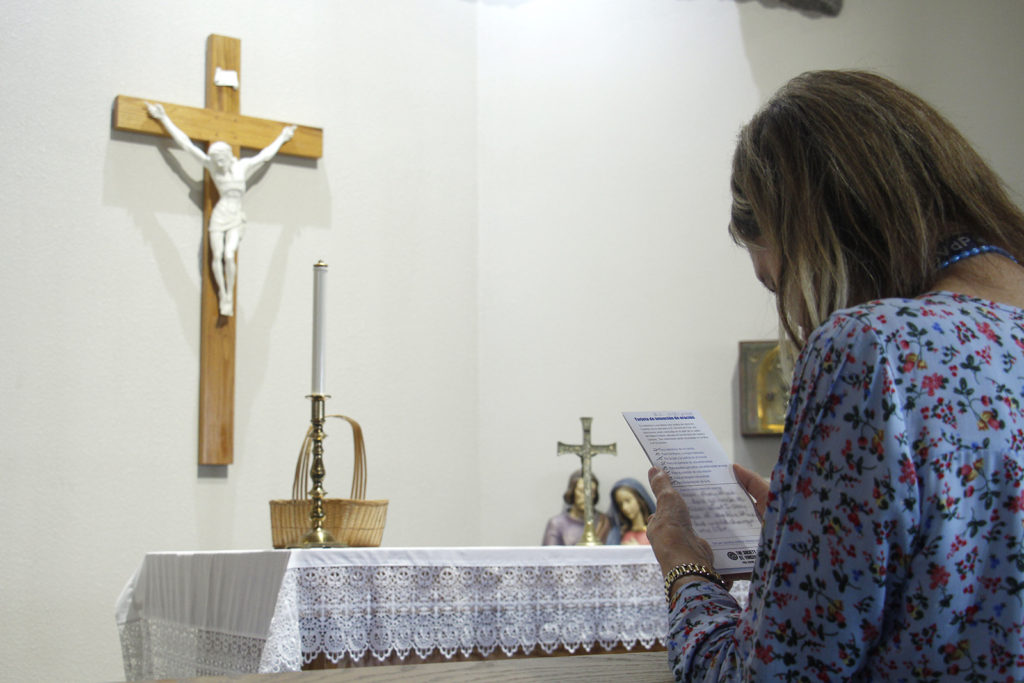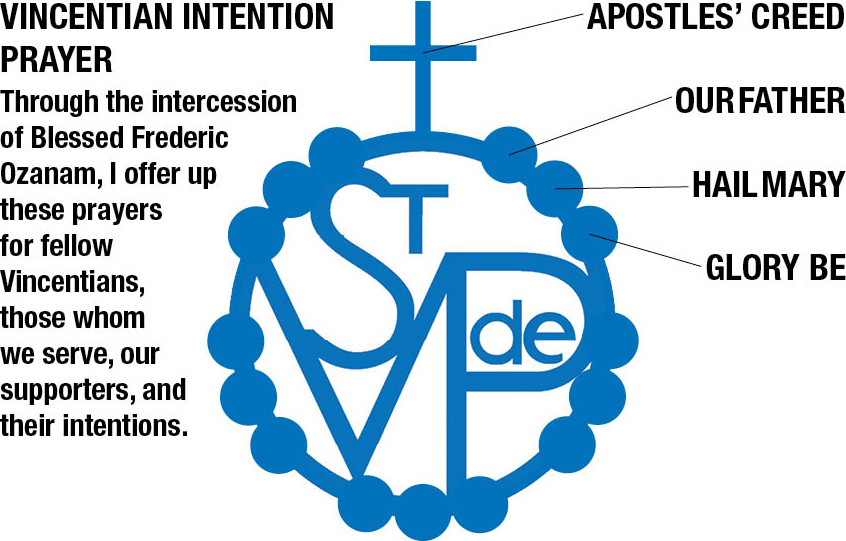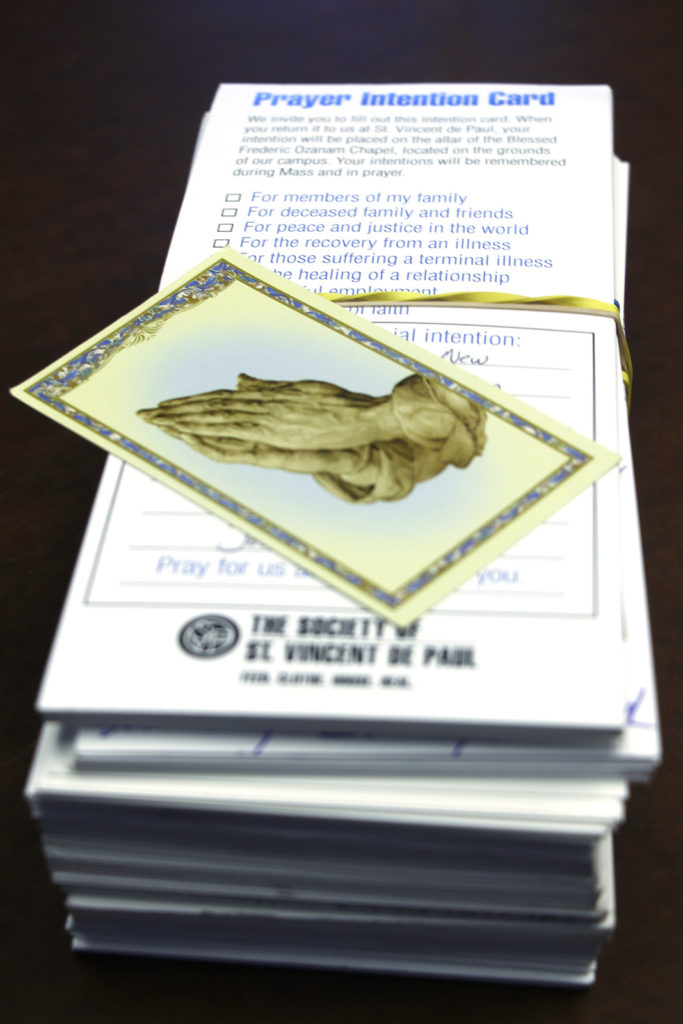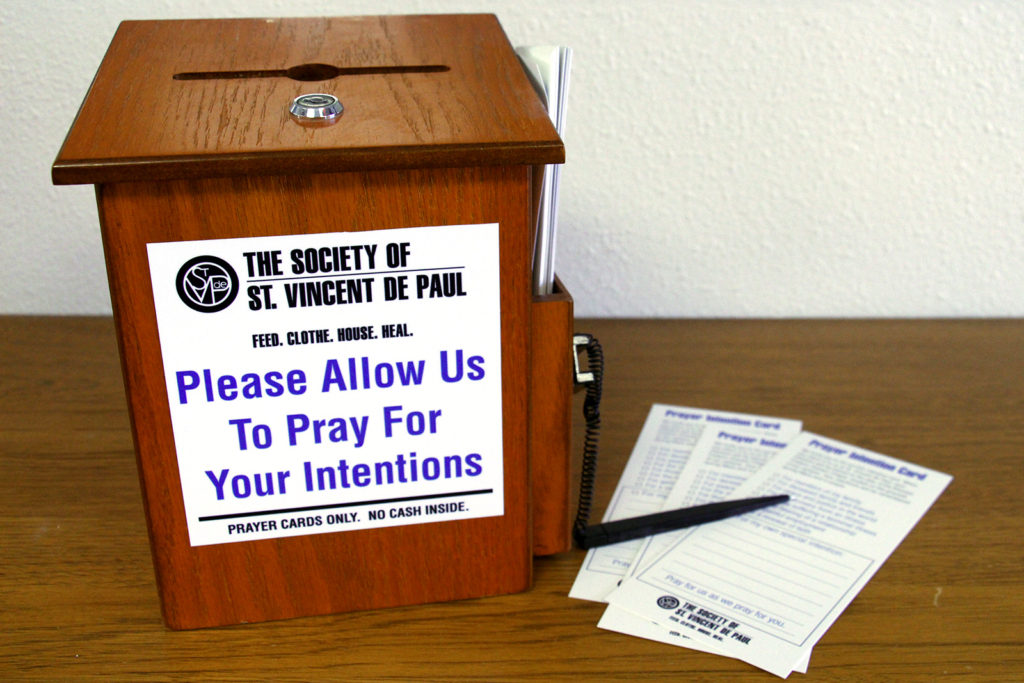

New chaplet strengthens spiritual work of St. Vincent de Paul
“Let us always pray for one another.”
Those were among the first words Pope Francis ever shared and exemplified from the papal balcony. They’re also similar to verbiage now floating among the vast community associated with Phoenix’s Society of St. Vincent de Paul.
SVdP Prayer Intentions and Chaplet
The SVdP Chaplet allows Vincentians to pray for each other, those they serve, supporters and their intentions.
Cost: $2 each, including card packet, or 10¢ each for the card alone.
Prayer intention boxes are also available for $46 each (to match the year SVdP came to the Diocese of Phoenix).
(800) 634-0839 or (602) 269-0009
Physically, the words “Pray for us as we pray for you” are planted toward the bottom of a prayer intention card that first circulated among donors via snail mail. The prayer request has gone somewhat viral. Those prayer intention cards are now widely available to individuals and families SVdP serves throughout its main and Human Services campuses, the Mesa and Sunnyslope dining rooms and the majority of Vincentian food pantries across the Diocese of Phoenix. They’re available to fill out during a home visit, too, and volunteers can also submit an intention.
Anyone who fills one out can mark among eight categories of prayer intentions — renewal of faith, gainful employment, illness, family members, world peace and justice, among them — or fill out a special intention in the blank space provided. So many opted for the latter that the card was re-designed with larger writing space.
In response, there is a new tangible way to know those prayer intentions are being prayed for: the SVdP Chaplet. It’s a spinoff of the traditional finger rosary whose 10 stationary beads line the outside of a metal ring. The SVdP Chaplet has five sets of three beads around the circumference with the charity’s globally-recognized logo atop the cross.
Each Vincentian who offers an SVdP Chaplet prays five consecutive sets of an Our Father, Hail Mary and Glory Be prayer. Its creator, Jack Ahern, envisions “Jubilarian Vincentians” to remain involved in retirement via the chaplet. Blessed Frédéric Ozanam, who established the Society of St. Vincent de Paul in 1833 (and for whom Phoenix’s Ozanam Manor transitional shelter for individuals is named), is called upon for intercession.

“The whole concept is to help Vincentians by praying for each other, for our supporters and those who we serve and their intentions,” said Ahern, who has been a Vincentian for almost 40 years.
To collect specific intentions, he designed a Prayer Intention Box. It’s similar to the monetary collection boxes with a paper-sized slit and keyhole, but the Prayer Intention box is a sturdy oak, has a one-inch side pocket for blank intention cards, a mounted pen and a sign that politely states, “Prayer cards only. No cash inside.” The prayer intention cards can be in English, Spanish or bilingual.
Ahern’s conference at Our Lady of Perpetual Help in Glendale conducted a trial run last fall. A prayer intention box was placed in the vestibule for supporters and in the food pantry for Vincentian clients. Vincentians also offered to fill them out during home visits. The parish received 90 intentions in a two-week span and the pastor blessed the intentions at Mass.
Vincentians pray for the intentions collected at the parish conference level during their regular meetings. They’re encouraged to offer that chaplet on their own, too. Ahern finds it easy to do so while in the car.

The prayer intentions collected at the dining rooms and SVdP’s main and Human Services campuses go directly to the care of Cynthia Bach, SVdP’s spiritual care advocate. She collects them daily, reads them and personally prays over the intentions she ethically guards. Staff and visitors generically pray for them during weekly Mass at the main campus where the intention cards are placed at the altar.
The stack could be as thick as three inches in just two weeks’ time. Last year she received about 2,000 prayer intention cards to pray for.
“I’ll spend a good hour every day praying for these intention cards,” Bach said. She routinely takes the completed prayer intention cards with her to Mass at St. Mary’s Basilica, too. Then, on the 18th of each month, she brings them with her to the Healing Mass at St. Joseph Maronite Church where holy oil is used to anoint the cards.
John Junker, director of Vincentian Support Services, likened Bach to a medieval anchoress such as Julian of Norwich, who devoted herself to a life of prayer. It was Bach’s idea to take the petitions to St. Joseph Maronite, and it’s Bach who organizes Bible studies in Sunnyslope, a regular prayer circle with Ozanam Manor residents and Mass attendance for “Oz” residents who seek it.
Junker clarified that no one SVdP serves is ever required to pray, “but giving the opportunity speaks to the need to serve the whole person, not just the hungry person.”
“It’s important to validate that we’re praying for them. That they’re not forgotten. This ministry is absolutely what we’re called to do. When you validate someone’s prayers and pray with them, it gives them hope,” Bach said.

A spiritual foundation is key to Vincentian work, and the ever-revolving prayer intentions coupled with the SVdP Chaplet — which has plans to grow in the Diocese of Phoenix then expand nationally and internationally — helps keep Vincentians in prayer mode.
When Ahern approached SVdP international president Renato Lima about the idea when the latter visited the Diocese of Phoenix in February, Ahern said the president offered his approval. He’s also hoping to promote it at the society’s upcoming National Assembly in Denver at the end of August.
Yes, when people hear St. Vincent de Paul, they think of helping the poor, Junker said, but in proper order. “The first goal of the society is to build the spirituality of its members. The second goal is to invite and help others to serve, and the third is to help the poor.”
Vincentians are working on creating a school version of the intention cards because students are heavily involved with SVdP via food drives, diaper drives and on-site visits to the dining rooms and main campus.





